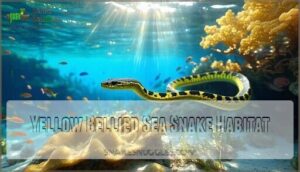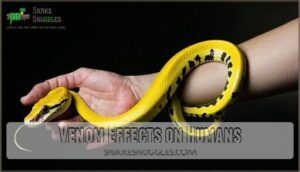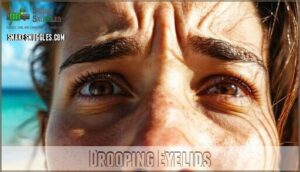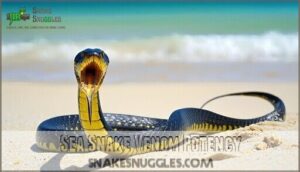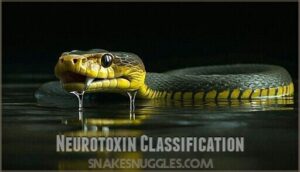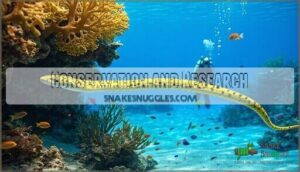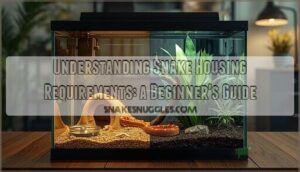This site is supported by our readers. We may earn a commission, at no cost to you, if you purchase through links.

These deadly compounds target your nervous system with surgical precision, blocking nerve signals and causing rapid paralysis.
You’ll face muscle weakness, breathing difficulties, and potentially fatal respiratory failure within hours of a bite.
The venom’s three-finger toxins bind to acetylcholine receptors, basically short-circuiting your body’s communication network.
While bites remain rare due to their docile nature, the potency means every encounter counts.
What makes these neurotoxins particularly fascinating is how they’ve evolved specific mechanisms that separate them from their land-dwelling cousins.
Table Of Contents
- Key Takeaways
- Sea Snake Venom Composition
- Yellow Bellied Sea Snake Habitat
- Neurotoxin Structure and Function
- Venom Effects on Humans
- Sea Snake Bite Symptoms
- Antivenom and Treatment
- Sea Snake Venom Potency
- Neurotoxin Classification
- Sea Snake Behavior and Venom
- Conservation and Research
- Frequently Asked Questions (FAQs)
- Are sea snakes neurotoxic?
- Which snake has neurotoxins?
- How poisonous is the yellow-bellied sea snake?
- Are yellow-bellied snakes poisonous to humans?
- Is sea snake venom a neurotoxin?
- How toxic is yellow-bellied sea snake venom?
- What is the anti venom for yellow belly snakes?
- Can you touch a yellow-bellied sea snake?
- How do yellow bellied sea snakes synthesize neurotoxins?
- What triggers neurotoxin release during sea snake bites?
- Conclusion
Key Takeaways
- You’ll face deadly neurotoxins that shut down your nervous system – Yellow-bellied sea snake venom contains three-finger toxins making up 50% of its composition, with an LD50 of just 0.067 mg/kg that’s 10 times more potent than cobra venom
- You’ll experience rapid paralysis and respiratory failure – The neurotoxins block acetylcholine receptors at your neuromuscular junctions, causing muscle weakness, breathing difficulties, and potentially fatal respiratory collapse within hours
- You’ll need immediate antivenom treatment to survive – Sea snake antivenom is most effective, but tiger snake or polyvalent antivenoms can substitute when specific treatment isn’t available, though time is critical
- You’re unlikely to encounter these snakes but should respect their danger – While yellow-bellied sea snakes are docile and rarely bite humans, their venom delivers 1-4 mg per bite; when less than 5 mg can be fatal
Sea Snake Venom Composition
You’ll find that the yellow-bellied sea snake packs one of the most potent venoms in the animal kingdom, containing multiple neurotoxins that can shut down your nervous system in minutes.
The venom’s composition includes three-finger toxins making up nearly 50% of total proteins, with Pelamitoxin serving as the deadliest component at lethal doses as low as 0.185 micrograms per gram of body weight.
Neurotoxins in Pelamis Platurus Venom
You’ll find that yellow bellied sea snake neurotoxins pack a deadly punch through sophisticated molecular weapons.
Pelamis platurus venom contains multiple neurotoxins, including the potent Pelamis Toxin A and several isotoxins that work together like a coordinated attack.
These neurotoxic compounds make up nearly 50% of the venom’s protein content, showcasing millions of years of venom evolution optimized for paralyzing prey through precise toxin mechanisms.
Pelamis Toxin B Characteristics
Among the neurotoxins in Pelamis platurus venom, Pelamis toxin B stands out as the second most potent component.
You’ll find this 60-amino acid polypeptide packs a serious punch with its beta-sheet structure and strategic disulfide bonds that make it incredibly stable.
The toxin’s effects stem from its role as a postsynaptic neurotoxin.
Key Pelamis Toxin B Characteristics:
- Molecular weight: 7-8 kDa with isoelectric point of 8.7
- Structure: Antiparallel beta-sheets, beta-turns, and random coils
- Toxicity: LD50 of 0.185 μg/g in mice (intravenous)
- Function: Postsynaptic neurotoxin blocking acetylcholine receptors
- Composition: Single amino acid difference from toxin A at position 10
Isotoxins and Their Role
Beyond the primary neurotoxin, you’ll find isotoxins that pack their own punch.
These structural cousins differ by just one amino acid but maintain deadly efficiency.
Think of them as backup singers in a lethal chorus—each contributes to the venom’s overall potency through functional redundancy.
| Feature | Primary Neurotoxin | Isotoxin A | Isotoxin B |
|---|---|---|---|
| Amino Acids | 60 residues | 60 residues | 60 residues |
| Key Difference | Reference toxin | Single residue change | Single residue change |
| Toxicity Level | Highest | Moderate | Moderate |
| Receptor Binding | Strong | Moderate | Moderate |
This isotoxin diversity represents evolutionary significance—nature’s insurance policy against prey resistance.
The systemic effects of sea snake venom can include nausea and abdominal pain.
The therapeutic potential of understanding these toxin variations could revolutionize antivenom development, making treatments more effective against sea snake venom’s complex cocktail of neurotoxin effects.
Venom Toxicity and LD50
You’ll find the yellow-bellied sea snake’s venom toxicity ranks among nature’s deadliest.
With a subcutaneous LD50 of 0.067 mg/kg, this sea snake toxin proves more potent than cobra venom.
Just 1-4 mg per bite can cause fatality, making dose response critical for survival outcomes and treatment decisions.
Yellow Bellied Sea Snake Habitat
The yellow bellied sea snake calls tropical waters home, gliding through warm seas across the globe.
You’ll spot them rarely near shore, as they spend their entire lives adrift.
Their sea snake habitat depends on several factors:
- Oceanic Distribution: Found in the Indian, Pacific, and parts of the Atlantic Oceans.
- Temperature Tolerance: Prefers waters above 18°C, avoiding cold currents.
- Prey Abundance: Follows schools of small fish, relying on prey-rich areas.
- Current Patterns: Drifts with ocean currents, sometimes traveling vast distances.
- Habitat Threats: Faces risks from pollution, climate change, and bycatch.
If you’re curious about sea snake venom, their neurotoxic venom is as widespread as their range.
Neurotoxin Structure and Function
You’ll discover that yellow-bellied sea snake neurotoxins possess a unique beta-sheet structure held together by four critical disulfide bonds.
These molecular weapons target your nervous system by binding to acetylcholine receptors, blocking the signals that control your muscles.
Beta-Sheet Structure
The yellow bellied sea snake’s neurotoxin mechanism relies on betasheet structure for its deadly effectiveness.
Spectroscopic analysis reveals antiparallel beta-sheets dominate these postsynaptic neurotoxins, creating beta-sheet stability essential for acetylcholine receptor binding.
Amino acid influence shapes this configuration, while functional implications include competitive receptor blockade.
This structural foundation enables the neurotoxin’s lethal paralytic effects.
Disulfide Bonds
You can’t underestimate how disulfide bonds hold yellowbellied sea snake neurotoxins together. These chemical bridges between cysteine residues create the rigid framework that makes Pelamis platurus venom so deadly.
Without proper bond formation during toxin folding, the neurotoxin mechanism fails completely. Bond disruption eliminates venom potency entirely, proving structural stability determines lethality.
- Four disulfide bonds create an unbreakable molecular cage
- Chemical bridges lock the toxin into its deadly shape
- Breaking these bonds turns poison into harmless protein fragments
- Each bond acts like a molecular rivet holding structure tight
- Without these connections, the postsynaptic neurotoxin crumbles apart, losing its lethality and deadly shape due to the absence of chemical bridges.
Acetylcholine Receptor Binding
Once those disulfide bonds lock the neurotoxin’s structure, you’re looking at a deadly molecular key that fits perfectly into acetylcholine receptors.
These yellowbellied sea snake neurotoxins from Pelamis platurus show incredible binding affinity and competitive inhibition at the neuromuscular junction.
The postsynaptic neurotoxin blocks nerve signals with toxin specificity rivaling alphabungarotoxin, which can lead to neuromuscular paralysis.
| Receptor Component | Toxin Interaction |
|---|---|
| Acetylcholine Binding Site | Competitive blockade |
| Receptor Subtypes | Nicotinic preference |
| Neuromuscular Junction | Primary target location |
| Binding Affinity | Extremely high |
| Neurotoxin Symptoms | Paralysis onset |
Neuromuscular paralysis can occur within hours of envenomation, resulting from the competitive blockade of acetylcholine receptors.
Venom Effects on Humans
If you’re bitten by a yellow-bellied sea snake, you’ll face severe muscle pain and stiffness as the neurotoxins attack your skeletal muscles.
The venom quickly progresses to respiratory failure and potential kidney damage, making immediate medical attention essential for survival.
Muscle Pain and Stiffness
When yellow-bellied sea snake venom enters your system, myotoxin mechanisms trigger immediate muscle damage.
You’ll experience intense muscle pain and stiffness as rhabdomyolysis impact breaks down muscle fibers.
These neurotoxin symptoms develop rapidly, making pain management challenging.
Stiffness duration varies, but long-term effects can persist without proper treatment, potentially progressing to complete paralysis.
Respiratory Failure
The yellowbellied sea snake’s neurotoxic action targets your respiratory muscles, causing diaphragm paralysis within hours.
As Pelamis toxin b blocks nerve signals, you’ll experience progressive breathing difficulty and cyanosis onset.
Without immediate medical intervention, asphyxiation risk becomes life-threatening. Ventilator dependence may be necessary as anticholinesterase effects worsen respiratory failure, making every breath a struggle for survival.
This is similar to the effects of black mamba neurotoxins.
Renal Failure
Your kidneys face serious danger when yellowbellied sea snake venom enters your bloodstream.
The neurotoxic action triggers rhabdomyolysis, breaking down muscle tissue and releasing myoglobin into your blood.
This myoglobinuria clogs your kidney filters, leading to acute renal failure.
Early detection matters – watch for reduced urine output, and dialysis options exist, but prognosis factors depend on quick treatment of these potent sea snake venom toxins.
Sea Snake Bite Symptoms
When a yellow-bellied sea snake bites you, the neurotoxins quickly attack your nervous system and cause distinctive symptoms that start mild but become life-threatening.
You’ll first notice drooping eyelids and drowsiness, followed by muscle pain, vomiting, and potentially fatal paralysis if you don’t get immediate medical treatment.
Drooping Eyelids
When sea snake venom’s neurotoxic components hit your neuromuscular junction, you’ll notice your eyelids starting to droop.
This ptosis mechanism happens because the toxin specificity targets acetylcholine receptors controlling your eyelid muscles.
The drooping eyelids signal early paralysis from the venom, and severity factors like venom amount affect how quickly this occurs, though recovery timeline depends on prompt antivenom treatment.
Drowsiness and Vomiting
Following the drooping eyelids, you’ll experience drowsiness and vomiting as neurotoxin effects worsen.
Yellow Bellied Sea Snake (Pelamis platura) venom creates these symptoms through systemic poisoning.
Envenomation Onset typically brings drowsiness within hours, while vomiting increases Dehydration Risk.
Symptom Severity varies, but both signs indicate serious neurotoxin exposure requiring immediate Supportive Care to prevent Aspiration Pneumonia.
Notably, only 25% result in actual envenomation.
- Your body’s fighting a losing battle against deadly neurotoxins
- Drowsiness signals your nervous system shutting down piece by piece
- Vomiting leaves you vulnerable and weakened when you need strength most
- These aren’t just symptoms—they’re warning signs of impending respiratory failure
Paralysis and Death
As drowsiness and vomiting worsen, Pelamis platura’s neurotoxin targets your nervous system directly.
The Envenomation Timeline accelerates rapidly—Paralysis Mechanisms shut down muscle control within hours.
Your diaphragm paralysis makes breathing impossible without Respiratory Management intervention.
Bite Severity determines Fatality Factors, but respiratory failure becomes lethal without immediate medical care and antivenom treatment.
Antivenom and Treatment
If you’re bitten by a yellow-bellied sea snake, you’ll need specific antivenom treatment immediately to survive the potent neurotoxins.
Sea snake antivenom made against Enhydrina schistosa venom effectively neutralizes yellow-bellied sea snake venom, though tiger snake or polyvalent antivenoms can substitute when specific treatment isn’t available.
Sea Snake Antivenom
When you’re bitten by a yellow-bellied sea snake, you’ll need specific sea snake antivenom fast.
This specialized treatment neutralizes the deadly neurotoxins circulating through your bloodstream.
Antivenom effectiveness depends on quick administration – ideally within hours of the bite.
Dosage guidelines vary based on symptom severity and your body weight.
Antivenom production involves immunizing horses with snake venom, then harvesting protective antibodies.
You can find resources for purchasing antivenom products online.
Watch for allergic reactions during treatment, as some people develop sensitivities to the horse-derived proteins.
Tiger Snake Antivenom
When sea snake antivenom isn’t available, you’ll need tiger snake antivenom as your backup option.
This equine-derived treatment shows Cross-Reactivity with yellow-bellied sea snake venom, though Antivenom Effectiveness isn’t guaranteed.
Clinical Studies reveal mixed results for snake bite treatment using tiger snake antivenom against sea snake neurotoxins.
Consider purchasing tiger snake antivenom for emergency preparedness.
Standard Dosage Guidelines recommend one to two vials intravenously, but Availability Issues make this challenging in remote areas where snake venom poisoning occurs.
Polyvalent Antivenom
When specific sea snake antivenom isn’t available, you’ll need polyvalent antivenom as your backup option.
This broad-spectrum treatment shows cross-reactivity against yellow-bellied sea snake neurotoxins, though antivenom effectiveness varies by manufacturer and dosage guidelines differ substantially.
You can purchase antivenom products from various online sources.
Critical treatment considerations:
- Availability issues – Rural hospitals often lack specialized antivenoms
- Future research – Scientists are developing improved formulations for better snakebite outcomes
- Medical treatments – Multiple vials may be required for severe snake venom poisoning
Sea Snake Venom Potency
You’ll be shocked to learn that yellow-bellied sea snake venom ranks among the most potent natural toxins on Earth, with an LD50 value of just 0.067 mg/kg that makes it substantially more dangerous than cobra venom.
Each bite delivers 1.0-4.0 mg of this deadly cocktail, where less than 5 mg can prove fatal to humans.
LD50 Values
You’ll find that Hydrophis platurus neurotoxin packs a serious punch with LD50 values of 0.067 mg/kg subcutaneously.
This marine snake venom outperforms cobra venom by nearly ten times in toxicity factors.
Measurement methods show Pelamis toxin b hits 0.185 µg/g intravenously in mice.
These LD50 comparison studies reveal why antivenom efficacy matters so much when dealing with this potent venom.
Venom Yield Per Bite
When you encounter a yellow-bellied sea snake, the venom yield per bite typically ranges from 1.0 to 4.0 mg.
Fang length affects injection volume substantially – their short fangs (approximately 1.5 mm) limit venom delivery during defensive encounters.
Bite severity depends on various risk factors, including the snake’s size and stress level.
Hydrophis platurus demonstrates venom variability between individuals, though toxin isolation studies show consistent neurotoxin concentrations across populations.
Toxicity Comparison
You’ll find the yellow-bellied sea snake’s venom remarkably potent compared to other snakes.
While cobra venom has an LD50 of 0.5 mg/kg, this marine predator’s neurotoxins pack a deadlier punch at just 0.05-0.067 mg/kg.
Even the infamous inland taipan can’t match these toxic peptides‘ severity.
Snake venom composition varies dramatically, but marine toxins consistently rank among nature’s most dangerous envenomation threats through specialized neurotoxin delivery systems.
Neurotoxin Classification
When you look at yellow-bellied sea snake venom, you’ll find it’s packed with three main types of deadly proteins that work together to shut down your nervous system.
The venom contains three-finger toxins at nearly 50% of total proteins, phospholipase A2 at about 33%, and cysteine-rich secretory proteins making up another 9% of this lethal cocktail.
Three-Finger Toxins
Three-finger toxins represent nearly 50% of yellow-bellied sea snake venom, with pelamitoxin being the most abundant component at 26%.
These toxic peptides feature a distinctive 3FTx structure with four disulfide bonds essential for their deadly function.
The disulfide importance can’t be overstated—break these bonds and the toxicity mechanisms collapse completely.
Venomous sea snakes rely on this neurotoxin’s snake venom composition for hunting success.
Phospholipase A2
While three-finger toxins dominate yellow-bellied sea snake venom, phospholipase A2 comprises 32.9% of total venom proteins.
These PLA2 enzymes break down cell membranes by hydrolyzing phospholipids, causing tissue damage and inflammation.
The PLA2 structure features catalytic sites that target membrane integrity, while their mechanism involves calcium-dependent reactions.
PLA2 evolution has optimized these snake venom components for enhanced toxicity and prey immobilization.
Some snake venoms, like the copperhead’s, also feature anticoagulant PLA2 enzymes.
Cysteine-Rich Secretory Proteins
Cysteine-rich secretory proteins make up 9.1% of yellow-bellied sea snake venom components, representing significant CRISP diversity within snake venomics.
These proteins don’t cause direct lethality but enhance venom effectiveness through CRISP interactions with ion channels.
CRISP function involves blocking calcium and potassium channels, while CRISP evolution shows accelerated adaptation.
CRISP targeting affects neuromuscular transmission, supporting postsynaptic neurotoxins in prey immobilization through sophisticated toxin characterization mechanisms.
Sea Snake Behavior and Venom
You might think these sea snakes are passive drifters, but they’re actually complex predators with sophisticated venom delivery systems that adapt their behavior based on threat levels.
Their defensive posturing and bite mechanics reveal fascinating insights into how marine reptiles have evolved to survive in one of Earth’s most challenging environments, showcasing their ability as sophisticated hunters.
Aggressive Behavior
Despite their fearsome reputation, Yellow Bellied Sea Snakes rarely show truly aggressive behavior.
You’ll find these Elapidae members are surprisingly docile creatures that prefer avoiding confrontation.
Provoked attacks remain uncommon, with most sea snake bites occurring during accidental encounters rather than deliberate aggression.
- Bite frequency stays low – aggressive snakes typically strike repeatedly, but these serpents usually bite once defensively
- Snake temperament leans passive – they’d rather escape than fight, saving their potent neurotoxin for prey
- Venom injection occurs reluctantly – defensive strikes often deliver less toxin than hunting bites
Defensive Behavior
When you encounter a Yellow Bellied Sea Snake, you’ll notice their defensive behavior kicks in fast.
These venomous snakes rely heavily on avoidance tactics and mimicry rather than aggression.
Their threat displays include coiling and positioning defensively.
Bite frequency remains low since they prefer escaping over confrontation.
This defensive behavior conserves venom expenditure while the neurotoxin-filled snake venom stays ready for genuine emergencies.
Venom Delivery
Through their short fangs, yellow-bellied sea snakes deliver venom with surprising efficiency.
You’ll find their bite mechanics rely on precise venom injection rather than deep penetration. Their fangs measure just 1.5 millimeters, yet they conserve neurotoxin delivery through controlled pressure systems.
Three critical venom delivery factors:
- Fangs and Delivery – Short fangs require direct contact for effective venom injection
- Venom Quantity – Each bite delivers 1.0-4.0 mg of potent snake venom
- Bite Mechanics – Delivery pressure guarantees neurotoxin reaches target tissues efficiently
Conservation and Research
You’re now entering the domain of yellow-bellied sea snake research, where scientists work to understand these creatures’ role in marine ecosystems and the threats they face.
From studying endoparasites that weaken these snakes to tracking how human activities impact their populations, researchers are piecing together a complex conservation puzzle.
Endoparasites and Diseases
Parasite Prevalence in sea snake species varies substantially across marine ecosystems, with endoparasites including roundworms and tapeworms commonly affecting yellow-bellied sea snakes in tropical waters.
Disease Impact from heavy parasite loads reduces swimming performance and reproductive success.
Co-infections with viruses, bacteria, and protozoa complicate health outcomes.
Treatment Strategies remain limited in wild populations, though marine biology research shows most snakes tolerate moderate infections.
Pollution exacerbates susceptibility to pathogens.
Human Interactions and Threats
Yellow-bellied sea snakes face mounting threats from fishing interactions, where they’re accidentally caught in nets and lines.
Habitat destruction and climate change alter their ocean environments, while pollution effects contaminate their food sources.
Though snake bite incidents remain rare, fatal encounters can occur without proper medical intervention, making conservation efforts essential for their survival, as these snakes are increasingly stressed by human activities.
Conservation Status and Efforts
Currently, you’ll find the yellow-bellied sea snake listed as "Least Concern" on the IUCN Red List, though population trends remain poorly studied.
Climate change and habitat loss threaten their ocean territories, while bycatch reduction efforts help protect them from fishing nets.
Marine conservation programs focus on establishing protected areas and monitoring endangered species populations to guarantee their survival and are part of broader conservation efforts.
Frequently Asked Questions (FAQs)
Are sea snakes neurotoxic?
Sea snakes pack venom that’ll turn your nervous system into a short-circuited electrical grid.
You’re dealing with potent neurotoxins that block nerve signals, causing paralysis and potentially fatal respiratory failure if untreated, which can be described as a short-circuited condition.
Which snake has neurotoxins?
Many snakes possess neurotoxins, including cobras, mambas, coral snakes, and sea snakes like the yellow-bellied variety.
You’ll find these toxins in elapid family members, which disrupt nerve function and cause paralysis through acetylcholine receptor blocking.
How poisonous is the yellow-bellied sea snake?
You’re dealing with one of the world’s most venomous sea snakes, with venom containing deadly neurotoxins that can cause paralysis and respiratory failure within minutes if untreated.
Are yellow-bellied snakes poisonous to humans?
Ever wondered about danger lurking beneath tropical waves?
You’re right to be cautious – yellow-bellied sea snakes pack extremely potent venom that’s more toxic than cobras, causing paralysis and potentially fatal respiratory failure if you’re bitten.
Is sea snake venom a neurotoxin?
Yes, you’re dealing with potent neurotoxins when encountering sea snake venom. These toxins target your nervous system, blocking nerve signals and causing paralysis, respiratory failure, and potentially death if untreated.
How toxic is yellow-bellied sea snake venom?
Yellow-bellied sea snake venom is extremely toxic, ranking among the most potent snake venoms worldwide. You’d face an LD50 of just 067 mg/kg, making it deadlier than cobra venom.
What is the anti venom for yellow belly snakes?
When facing a potentially serious medical situation, you’ll need sea snake antivenom produced against Enhydrina schistosa venom, which effectively neutralizes yellow-bellied sea snake toxins.
Tiger snake or polyvalent antivenoms serve as alternatives when specific treatment isn’t available.
Can you touch a yellow-bellied sea snake?
You shouldn’t touch a yellow-bellied sea snake because they’re extremely venomous.
Their toxins can cause paralysis, respiratory failure, and death.
While bites are rare since they’re not aggressive, handling them risks potentially fatal envenomation requiring immediate medical treatment.
How do yellow bellied sea snakes synthesize neurotoxins?
Like a biochemical factory churning out deadly products, you’ll find these snakes produce neurotoxins through specialized venom glands.
Their cells synthesize proteins using DNA templates, creating complex three-finger toxins that disrupt nerve signals when injected.
What triggers neurotoxin release during sea snake bites?
When you’re bitten, the snake’s venom glands contract reflexively, forcing neurotoxins through hollow fangs into your tissue.
This defensive mechanism activates automatically during strikes, releasing potent toxins that’ll quickly disrupt your nervous system’s normal function, utilizing a defensive mechanism.
Conclusion
Understanding yellow bellied sea snake neurotoxins isn’t just academic curiosity—it’s potentially life-saving knowledge.
These specialized toxins represent millions of years of evolutionary refinement, creating compounds that can shut down your nervous system with frightening efficiency.
While encounters remain uncommon, the severity of envenomation demands respect and preparation.
Whether you’re a marine biologist, ocean enthusiast, or simply curious about nature’s deadliest creations, recognizing these neurotoxins’ power helps you appreciate both their danger and remarkable biological complexity.
- https://pubmed.ncbi.nlm.nih.gov/24704853/
- https://pmc.ncbi.nlm.nih.gov/articles/PMC3202789/
- https://apps.dtic.mil/sti/tr/pdf/AD0766724.pdf
- https://ontosight.ai/glossary/term/yellow-bellied-sea-snake-neurotoxin--679d1beb38099fda3cfa2b1d
- https://cbn.co.za/featured/cape-town-beach-latest-how-deadly-is-the-yellow-bellied-sea-snake/

